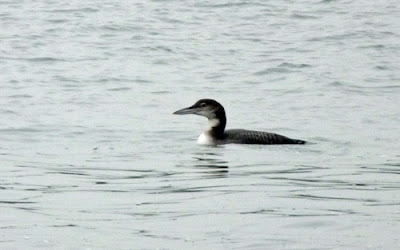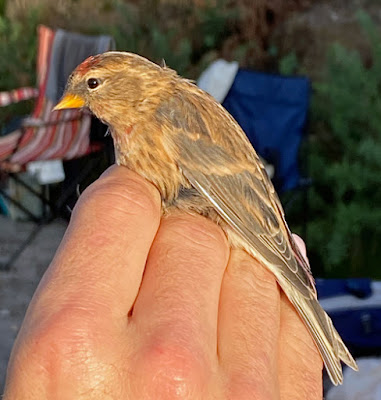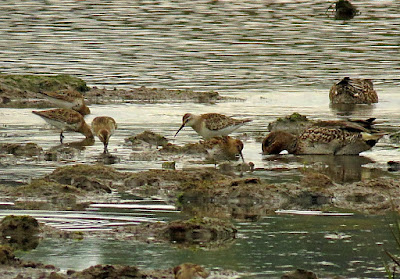Well we managed to keep to our challenge of reaching a 100 species which we just managed to top this month but there were still species that we missed so the possibility of doing the same in December I believe is still on.
With going into a second lockdown we were very aware of keeping local so the month's birding started for us on the 2nd with a short drive to Longham Lakes before lockdown started. It was a real grey day with the possibility of a shower but the birds we wanted to catch up with were all around the north end of the South Lake. Arriving mid morning there were a few people walking around the lakes and most were birders. Our first birds were the local species Coot, Mallard and the usual gulls then we picked up our first Great White Egret. Our next target was the Green-winged Teal and we found that on the north end of the north island sat in amongst a few Common Teal and one or two Little Egret and Mallard.. Unfortunately it was a tad too far to get a really good shot of it.
It was about this time a Dorset birder that we hadn't met for quite some time Bagsy aka Paul Baker, a real character that now lives nearby, came along and we were able to have a bit of a catchup and was able to point him in the right direction for the Green-winged Teal. We walked on across the causeway finding another Great White stood out in the field west of the lakes. We then met George Green and asked him if he had seen the Great Northern Diver and he told us that it's been around the corner of the lake where we were. Scanning we eventually picked it up as it surfaced and whilst we watched it came real close to our bank and gave excellent views. There was just one other target species that we hadn't seen and we were told it had been on the small island in the south of the lake but we couldn't find it there. The sky had darkened and a few spots of rain were felt and I hadn't a waterproof so we decided to start walking back to the car. As we approached where we had seen the Green-winged Teal we thought we'd take another look and there stood almost next to it was a Cattle Egret, where it came from and how it passed us to get there know one knows, but none-the-less a good way to finish a morning's birding and just as the rain was starting.
 |
| Green-winged Teal © Nick Hull |
 |
| Great Northern Diver © Nick Hull |
 |
| Cattle Egret © Nick Hull |
What a great start to the month's birding but we knew it would be harder to get to the hundred once the lockdown started so next day we went off to Studland and started at Jerry's point in the hope that the Long-tailed Duck was still in the area. We spent some time scanning the harbour from the shores of Brownsea Island across to Furzey and Green Islands and into Brand's Bay. We managed to find Common Scoter and Scaup, we picked up our first Goldeneye but the water was very choppy and birds were hard to find and see on the water. Before we left we added Red-breasted Merganser to our list which were in a raft in the shelter of Furzey Island there was also a diving duck with them with a low profile possible a Long-tailed Duck but we couldn't quite clinch it. We moved on to Middle Beach and checked out over the Poole Bay and only added Black-necked Grebe. A slow drive through the village didn't produce the Ring-necked Parakeets but we couldn't spend much time here as we were expecting a delivery at home so we called it a day. Though not quite as we took a short detour on the way home cutting across Hartland Moor in case we could add Hen Harrier or Merlin which we didn't but did see Fielfare and Redwing which was a bonus.
Over the rest of the month which was spent around various location of the harbour we continued to added many of the usual species of wader and woodland birds. Highlights were a local surprise whilst at Lytchett View on the 4th with a single Egyptian Goose which flew into the bay. Two days later we visited Arne and added Spoonbill to the list with 31 roosting on Shipstal Point. The 19th was a wet and stormy day so we popped around the harbour from Sandbanks ferry back to home the only highlight was single Sandwich Tern on Baiter. Our next was whilst taking a drive around across Hartland and we had a Merlin cross the road at Slepe Copse on the 21st.
Next morning Ian found a Goosander out in Lytchett Bay and as they are scarce on the patch Jackie and I had a walk to the viewing area at the end of footpath 12. It took a while but we eventually spotted it out in the main channel in the west of the bay. We had to wait till the 24th to get Marsh Harrier on our Lytchett list when we had an adult female being harried by a couple of Carrion Crow over the Holton side of the bay. We were now at 99 species and very close to the end of the month we decided to have a drive out to the Cranborne Chase to see if we could add one or two more species to the month's list and indeed we did with Corn Bunting and Red Kite and Yellowhammer. We finished the day in the Lower Avon Valley where we had 5 Ruddy Shelduck with a large mixed flock of Canada, Greylag and Egyptian Geese in a field between Sopley and Bransgore.
Though it was nice to see the Ruddy Shelduck as they were the 104th species for the month they aren't on the British list as they are considered a feral species from the European feral population and not true wild birds. I think many birders think perhaps they should be on category C of the British list and countable as the European feral population are increasing and sustainable which is the most likely origin of these super looking ducks. Also they turned out to be just inside Hampshire. So our month ended on a 103 species.
 |
| Egyptian Goose & Ruddy Shelduck near Sopley. |
What will December bring as we can travel a little further round the county hopefully picking up a few more species who knows...























